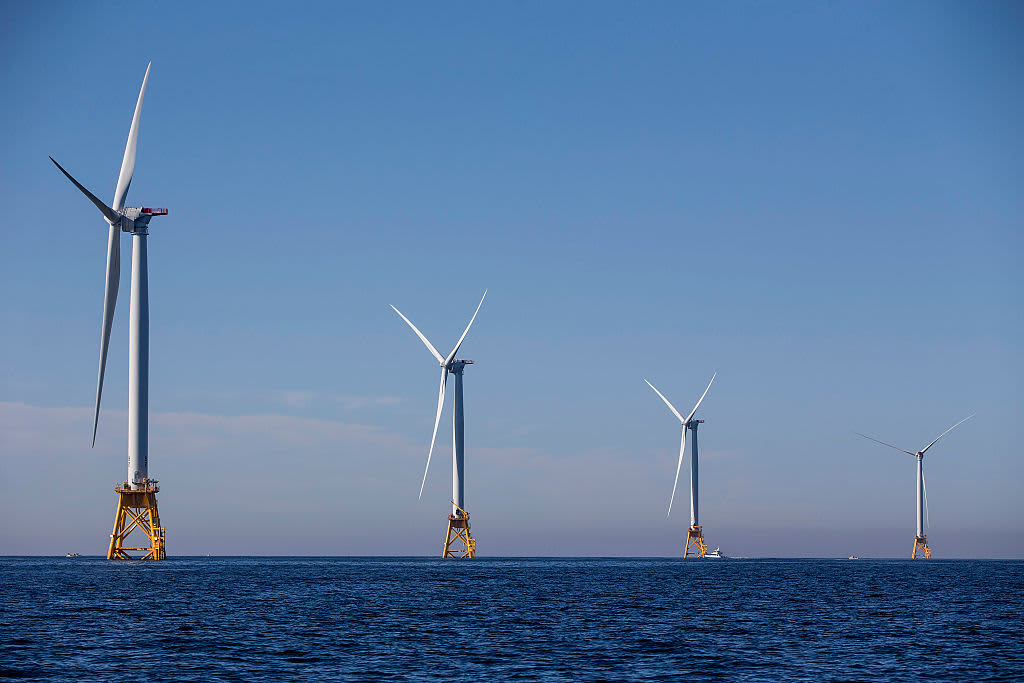The Block Island Wind Farm, pictured above, began commercial operations at the end of 2016.
Scott Eisen | Getty Images
Stretching for thousands of miles, the east coast of the United States is home to major cities, stunning beaches and millions of people. Soon, though, it could also host several major offshore wind farms, a development that would have a significant effect on America’s energy mix.
At the moment, the offshore wind sector in the U.S. is small. The country’s first offshore wind farm, the 30 megawatt, five turbine Block Island Wind Farm, only started commercial operations at the end of 2016.
Located off the coast of Rhode Island, the facility is operated by Orsted, a Danish firm.
“It’s been quite a ride the last five years in the sense that you’re seeing multiple states on the Eastern Seaboard come out in a big way with offshore wind targets and carve outs,” Thomas Brostrøm, CEO of Orsted North America Offshore, told CNBC in a phone interview.
Brostrøm went on to list a number of states that were looking to ramp up their offshore wind capacity, including New York, which is targeting 9 gigawatts by 2035; New Jersey, where authorities are aiming for 7.5 GW by 2035; and Virginia, which wants to have 5.2 GW by 2034.
Orsted is working on the development of several offshore wind farms in American waters and is one of a number of firms looking to establish a foothold in the sector.
Just last week, in a $1.1 billion deal, oil and gas giant BP took 50% stakes in Equinor’s Empire Wind and Beacon Wind projects, which are located off the coasts of New York State and Massachusetts respectively.
A game of catch-up
The potential for offshore wind in the U.S. is significant. The U.S. Department of Energy (DOE) has previously stated that offshore wind in America had “a technical resource potential” of over 2,000 GW.
To put this figure in perspective, global cumulative offshore wind installations amounted to 29.1 GW at the end of last year, according to the Global Wind Energy Council.
In comments sent to CNBC via email, Max Cohen, a principal analyst at Wood Mackenzie, said it had a base case forecast of nearly 25 GW of installations in the U.S. this decade.
“This opportunity is primarily located in the Northeast U.S. where state policies and favorable conditions are driving the industry, but over time we expect the Southeast and the West Coast to become home to offshore wind build as well,” he said.
While there is undoubted room for a significant ramp-up of offshore wind in the U.S., it clearly has a long way to go in order to catch up with more mature markets such as Europe. Offshore wind capacity there currently stands at over 22 GW, according to figures from industry body WindEurope.
Potential headwinds
Wood Mackenzie has listed eight factors that could affect its forecast for America’s offshore wind sector, ranging from federal policy to state targets and supply chains.
In its “bull” scenario, the U.S. develops almost 34 GW of capacity in the 2020s, while a “bear” outcome would see less than 15 GW come online.
Another factor that could affect Wood Mackenzie’s outlook is that of permitting, an area which Cohen described as “troubled” and needing more clarity.
The American Wind Energy Association has described the industry in the U.S. as “carefully regulated,” noting that developers have to get permits “from all levels of government, local through federal.”
Wood Mackenzie’s Cohen explained that, compared to Europe, the U.S. had a “more fractured development process, with many levels of government fully reviewing and permitting projects only after they’ve won a power purchase agreement.”
A renewable corporate power purchase agreement, or PPA, refers to a deal where an energy producer sells power to a business at a fixed price over a set period of time.
“The development process varies country to country in Europe, but generally there is less risk that a project could unravel after it’s won offtake for its power,” he added.
Cohen explained that the industry was currently in “a wait-and-see-mode” ahead of the Bureau of Ocean Energy Management finishing its review of the 800 MW Vineyard Wind project. Planned for waters off the coast of Massachusetts, the scheme involves Avangrid Renewables – part of the Iberdrola Group – and Copenhagen Infrastructure Partners.
“A more streamlined process from the U.S. federal government and more coordination among the states (particularly over the medium-term on transmission issues) would help a lot,” he added.
Political will
Despite the challenges, Orsted’s Thomas Brostrøm remains positive about the development of offshore wind in the U.S. over the coming years.
He did, however, seek to emphasize one area that could have a big effect when it comes to the development of the industry, especially with a presidential election less than two months away.
“Given that we’re dealing with large infrastructure projects, and we need to obtain numerous permits, both from states and from … federal, I think political will is always important,” he said.
“And again, at the highest level, having an understanding as to what renewables and offshore wind can provide to society is in many ways also a political topic.”
